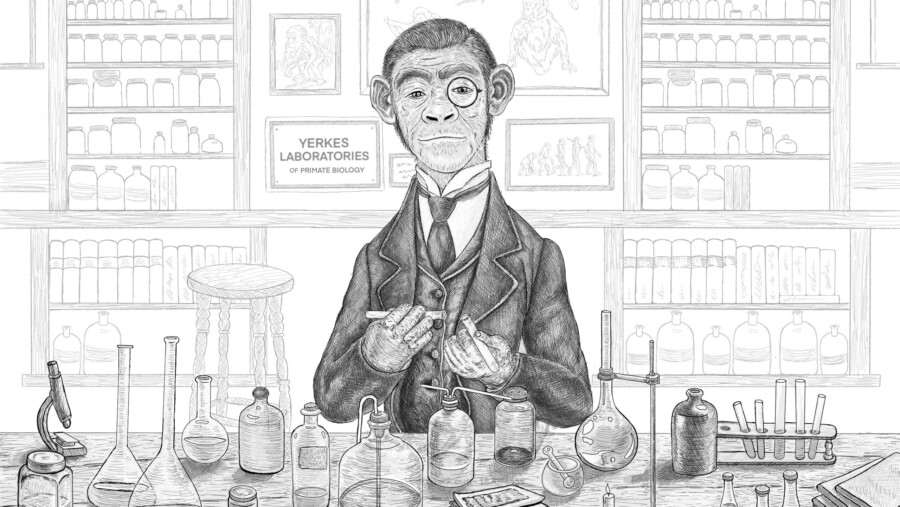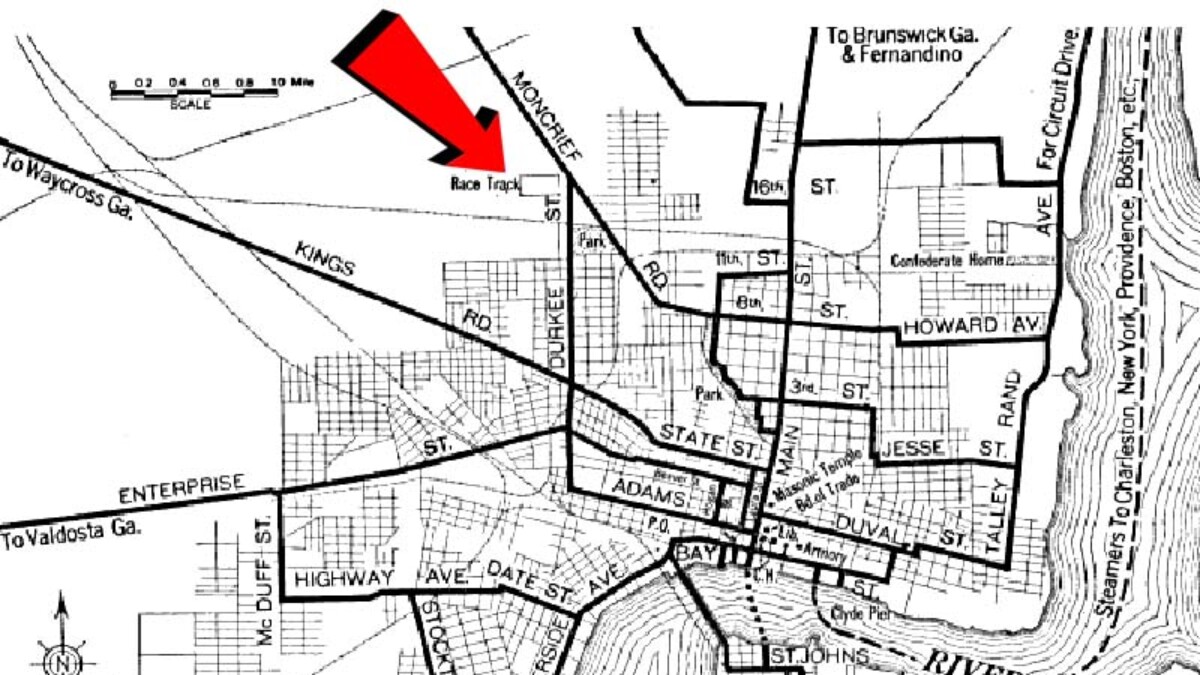
Unseen and unknown by most in the region, from 1930 to 1965, Orange Park was home to one of the largest chimpanzee research operations in the world, the Yerkes Laboratories of Primate Biology. The mysterious “Monkey Farm” has given rise to one of the First Coast’s strangest legends: that a half-human, half-chimp “humanzee” was born within its walls. Could there be truth behind the story?
The legend
Located on Kingsley Avenue two miles from the Orange Park riverfront is the Rockefeller Medical and Professional Center, an unassuming office park with an extraordinary past. The campus of concrete block buildings was once home to the Yerkes Laboratories for Primate Biology, founded by Yale primatologist Robert M. Yerkes in 1930. Locals at the time viewed the laboratory with an air of mystery; Florida Times-Union columnist Bill Foley wrote that it inspired “dark, deep speculation, wild exaggeration and tall tales shamelessly told around a thousand campfires.”
This forgotten history is interesting enough, but the Yerkes lab has entered the realm of Northeast Florida legend due to the extraordinary claim that an extremely unorthodox experiment occurred there. According to the tale, the Yerkes scientists engaged in a wildly unethical experiment that saw the birth of a living, breathing “humanzee”: a half-human, half-chimp hybrid. Shortly thereafter, as the story goes, they destroyed the infant and covered up what they’d done, leaving behind only a pervasive urban legend.
The definitive version comes from Dr. Gordon Gallup, a respected psychology professor at the University of Albany who has an interest in hybrid creatures. For more than 20 years, he’s been relating the story of how he learned of the Orange Park humanzee in documentaries and news pieces. As he told me:
“Well, I had a former colleague who passed away quite a while ago who happened to be at Orange Park when this supposed experiment took place. According to the rumor, a female chimpanzee who was in heat was artificially inseminated with human DNA from an obviously undisclosed source, and nine months later – the gestation for pregnancy in chimpanzees and humans is about the same – it gave rise to a live birth. Within a week or so after the birth of the hybrid, the decision was made to euthanize the infant, because of all the profound social and psychological and religious repercussions.”
It’s easy to see why this story has caught on: it’s both plausible and existentially terrifying. But did it happen? Could it happen? To answer these questions, let’s dive into what is known for sure.
Inside the Monkey Farm
Whatever the truth is of the humanzee, the Yerkes Laboratories were quite real. Robert M. Yerkes, a psychobiologist from Yale University with an interest in primate intelligence, built the facility to rear and study captive chimps. He chose Orange Park as the location due to its warm climate, cheap land and relatively easy transportation to New Haven by train and ship. The property comprised 182 acres, though only 10 acres were developed into buildings to house and study the apes.
The facility, originally the Yale Laboratories of Primate Biology, was renamed for Yerkes when he retired in 1941. It started with four chimps, and by 1965 the population had grown to 67, along with 11 gorillas, 27 orangutans and more than 100 monkeys of some 20 different species. Over the years, many renowned scientists worked at the Yerkes Laboratories, including Henry Nissen, Karl Lashley and Kenneth Spence.
The Yerkes Laboratories kept its distance from the Orange Park community. In 1930, Yerkes wrote, “It is true we do not court publicity. Far too often it results in misunderstanding, unenlightened criticism or, worse still, ridicule.” The facility did periodically host visitors and school trips, and staff sometimes took the apes around town; Yerkes himself could occasionally be seen driving to the post office with a favorite chimp, Judy, in the passenger seat.
The Orange Park research station became obsolete when the federal government decided to fund regional primate labs, and in 1965, Yale sold it to Emory University. Emory relocated the apes and monkeys to a new facility near its Atlanta campus and shuttered the old Monkey Farm for good. Developer Marvin Wilhite purchased the property, turning the 172 wooded acres into the Foxwood residential subdivision. Unusually in demolition-happy Northeast Florida, he kept the old lab buildings for an office park. Businesses now operate where experiments once occurred; the caretaker’s house is now the Granary, a health food shop.
A history of hybrids
The story of a supposed humanzee experiment at Yerkes Laboratories has some company in the sphere of weird science. During the 1920s, Soviet biologist Ilya Ivanov conducted unsuccessful experiments attempting to create hybrid chimp-human embryos (although not, apparently, in hopes of creating an unstoppable army of ape-men in service to Stalin, as has been reported), while news stories from the 1980s claimed similar experiments occurred in China before the Cultural Revolution of the 1960s. Stories such as these captured imaginations around the world, popularizing the question of whether a humanzee is possible.
Interest in the question spiked in the 1970s, when a chimp named Oliver drew attention due to his unusual appearance and behavior, which observers found uncannily human. Apparently originally from the Congo, Oliver was bought by handlers Frank and Janet Berger, who soon noted (and publicized) his odd traits. Photos of Oliver caught the attention of Dr. Gordon Gallup, the psychologist who recounted the Yerkes humanzee story above, who felt the strange ape might just be a human-chimp hybrid.
“When I first saw Oliver, he showed a lot of very peculiar, seemingly human-like characteristics,” says Gallup. “For instance he showed a predisposition to walk upright, he had a flat, peculiar-shaped nose and lips, and so on and so forth. And I thought when I first saw Oliver that he might in fact be a humanzee.”
Oliver inspired fascination for decades. In 1996, geneticists determined to find the truth about Oliver by examining his karyotype, or set of chromosomes. Offspring inherit half their chromosomes from each parent; chimps have 48 chromosomes while humans have 46, meaning a humanzee would have 47. The study demonstrated that Oliver had the normal 48 chromosomes. “He was a regular chimp,” says Gallup. “Well, a very strange, maybe even a mutant chimp, but he clearly was not a humanzee.”
So, could half-human, half-ape beings walk the earth with us? Gallup thinks it’s possible. Hybridization is fairly common among many types of animals. The best known example is the mule, the offspring of a male donkey and a female horse with characteristics of both parents. Hybrids occur among primates as well, says Gallup. “It turns out that rhesus monkeys and baboons – which are at least as different, but maybe even more different from one another than humans and chimpanzees – will interbreed and hybridize and produce a viable offspring. They’re called rheboons.”
A legend comes to Orange Park
In 2003, a British television documentary took up the question of human-chimp hybrids to a wide audience. Humanzee: The Human Chimp primarily focused on Oliver while touching on other anecdotes and stories, and aired on Channel 5 in the UK and later on the Discovery Channel in North America. Of special interest in the Jacksonville area, it featured Dr. Gordon Gallup recounting the story he’d heard about the Yerkes Laboratories humanzee for the first time in public.
The documentary led to an explosion of interest in hybrids and the term “humanzee”; Google Trends shows searches for “humanzee” spiked starting in May 2004, after the show aired on the Discovery Channel. From there, numerous TV programs, YouTube videos, articles and podcasts have covered the topic. Gallup has been interviewed numerous times since, further sharing the Yerkes story.
It was at this point that the Orange Park humanzee rose to the status of true Jacksonville-area legend along the lines of Ghost Light Road, the St. Johns River Monster, the ghost of TacoLu, and the mysterious Betz sphere. It’s easy to see why it caught on. First, it built on long-standing fascination with the Monkey Farm in Orange Park. Many longtimers can testify to how alien and intimidating the secretive facility and its scientists seemed to the small, rural town. It was a perfect setting for scary stories and legend-tripping, the right of passage in which young folks test their mettle by braving frightening locations.
One informant, Kirk Luman, says he “stayed in the building with a couple of friends in the early 70s. It had been abandoned for a while. It was a dare because we heard it was haunted by monkeys and mad scientists.” Barbara Gayle Johns reports, “Heard of it as a child. Was born in 1950. Was always scared we would go there and see this thing. Never knew the real story or if there was one!”

The story’s plausibility has no doubt led to some of its intrigue. It seems to fall within range of some of the scientific horrors of the period – eugenics, the Tuskegee experiments, etc. – as well as some of the real research at Yerkes Laboratories that explicitly intended to divine the boundary between human and ape. Two experiments, one by Luella and Winthrop Kellogg and the other by Cathy and Keith Hayes, involved scientists raising baby chimps in their Orange Park homes alongside their children to see how “human” an ape reared in a human environment might be.
Regardless of the truth of the story, the humanzee of Orange Park has become an indelible part of First Coast folklore, and it shows no sign of going away. “I can see why people find it so intriguing and fascinating,” says Gallup. “Unlike things like flying saucers, which may or may not exist, the question of hybridization is an empirical question. It’s not a matter of faith, it has the potential, whether or not it ever happens, to become a matter of fact.”




















